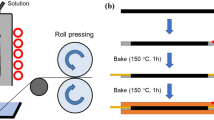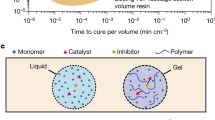Abstract
A new process technique called rapid heat cycle molding (RHCM) has been developed using a carbon nanotube (CNT) web film as a heat source for the mold. Although various heating technologies have been applied as RHCM techniques, low energy efficiency has caused productivity to decrease. To improve this issue, the RHCM process was implemented using a CNT web film for more efficient heating. A multilayer structure module was designed to apply the CNT web film to a full-size injection mold. The RHCM process was implemented by designing stable heat transfer and electrical insulation through a multilayer structure module. When power was applied, the temperature rose quickly, with the highest heating rate reaching 41 °C/s at 40 kW, and the highest temperature achieved at about 300 °C. The temperature uniformity and stability were tested on 6 points of the cavity surface, and an average of 97% temperature uniformity and stability was observed during heating. In production testing of the Center Fascia (CTR.FASCIA), which is an internal automobile part made of polycarbonate/polybutylene terephthalate composites, an RHCM process was conducted. The width and depth of weld lines in the molded products were eliminated, and a 26% improvement in glossiness and surface quality was observed compared to the conventional injection molding process (CIM). CNT web film is a versatile and flexible material that can be applied in various forms, and it has been confirmed that by utilizing this material to create a multilayer structure module, the RHCM process can be performed reliably.

















Similar content being viewed by others
References
Yao D, Kim B (2002) Development of rapid heating and cooling systems for injection molding applications. Polym Eng Sci 42:2295–2481. https://doi.org/10.1002/pen.11133
Chen S-C, Chang Y, Chang Y-P, Chen Y-C, Tseng C-Y (2009) Effect of cavity surface coating on mold temperature variation and the quality of injection molded parts. Int Commun Heat Mass Transfer 36:1030–1035. https://doi.org/10.1016/j.icheatmasstransfer.2009.06.020
Wang G, Hui Y, Lei Z, Guoqun Z (2018) Research on temperature and pressure responses in the rapid mold heating and cooling method based on annular cooling channels and electric heating. Int J Heat Mass Transf. https://doi.org/10.1016/j.ijheatmasstransfer.2017.09.126
Yao D, Kimerling TE, Kim B (2006) High-frequency proximity heating for injection molding applications. Polym Eng Sci 46:938–945. https://doi.org/10.1002/pen.20548
Huang M, Tai N (2009) Experimental rapid surface heating by induction for micro-injection molding of light-guided plates. J Appl Polym Sci 113:1345–1354. https://doi.org/10.1002/app.30053
Menotti S, Hansen HN, Bissacco G, Calaon M, Tang PT, Ravn C (2014) Injection molding of nanopatterned surfaces in the sub-micrometer range with induction heating aid. Int J Adv Manuf Technol 74:907–916. https://doi.org/10.1007/s00170-014-6010-5
Chen S-C, Jong W-R, Chang J-A (2006) Dynamic mold surface temperature control using induction heating and its effects on the surface appearance of weld line. J Appl Polym Sci 101:805–126. https://doi.org/10.1002/app.24070
Chen S-C, Minh PS, Chang J-A (2011) Gas-assisted mold temperature control for improving the quality of injection molded parts with fiber additives. Int Commun Heat Mass Transfer 38:304–312. https://doi.org/10.1016/j.icheatmasstransfer.2010.11.001
Chen S-C, Lin C-Y, Chang J-A, Minh PS (2013) Gas-assisted heating technology for high aspect ratio microstructure injection molding. Adv Mech Eng 5. https://doi.org/10.1155/2013/282906
Wang G, Zhao G, Li H, Guan Y (2009) Research on a new variotherm injection molding technology and its application on the molding of a large LCD panel. Polym-Plast Technol Eng 48:671–681. https://doi.org/10.1080/03602550902824549
Jeng M-C, Chen S-C, Minh PS, Chang J-A, Chung C (2010) Rapid mold temperature control in injection molding by using steam heating. Int Commun Heat Mass Transfer 37:1295–1304. https://doi.org/10.1016/j.icheatmasstransfer.2010.07.012
Jansen KMB, Flaman AAM (1994) Construction of fast-response heating elements for injection molding applications. Polym Eng Sci 34:894–897. https://doi.org/10.1002/pen.760341105
Chen H-L, Chien R-D, Chen S-C (2008) Using thermally insulated polymer film for mold temperature control to improve surface quality of microcellular injection molded parts. Int Commun Heat Mass Transfer 35:991–994. https://doi.org/10.1016/j.icheatmasstransfer.2008.04.017
Lee J, Turng L-S (2010) Improving surface quality of microcellular injection molded parts through mold surface temperature manipulation with thin film insulation. Polym Eng Sci 50:1281–1289. https://doi.org/10.1002/pen.21658
Yang H, Yilmaz G, Han G et al (2020) A quick response and tribologically durable graphene heater for rapid heat cycle molding and its applications in injection molding. Appl Therm Eng. https://doi.org/10.1016/j.applthermaleng.2019.114791
Li Y-L, Kinloch IA, Windle AH (2004) Direct spinning of carbon nanotube fibers from chemical vapor deposition synthesis. Science 304:276–278. https://doi.org/10.1126/science.1094982
Janas D, Koziol KK (2016) Carbon nanotube fibers and films: synthesis, applications and perspectives of the direct-spinning method. Nanoscale 8:19475–19490. https://doi.org/10.1039/C6NR07549E
Wang G, Zhao G, Li H, Guan Y (2010) Research of thermal response simulation and mold structure optimization for rapid heat cycle molding processes, respectively, with steam heating and electric heating. Mater Des 31:382–395. https://doi.org/10.1016/j.matdes.2009.06.010
Wang G, Zhao G, Wang X (2013) Experimental research on the effects of cavity surface temperature on surface appearance properties of the moulded part in rapid heat cycle moulding process. Int J Adv Manuf Technol. https://doi.org/10.1007/s00170-013-4921-1
Wang G, Zhao G, Wang X (2014) Development and evaluation of a new rapid mold heating and cooling method for rapid heat cycle molding. Int J Heat Mass Transf. https://doi.org/10.1016/j.ijheatmasstransfer.2014.06.062
Funding
This work was supported by the Technology Innovation Program (Grant No. 20004272) funded by the Ministry of Trade, Industry and Energy, Republic of Korea.
Author information
Authors and Affiliations
Contributions
All authors contributed to the study conception and design. Material preparation, experiment, and analyzed experiment data were performed by Hyeon Min Lee and Young Bae Ko. The first draft of the manuscript was written by Hyeon Min Lee, and all authors commented on previous versions of the manuscript. All authors read and approved the final manuscript.
Corresponding authors
Ethics declarations
Competing interests
The authors declare no competing interests.
Additional information
Publisher's Note
Springer Nature remains neutral with regard to jurisdictional claims in published maps and institutional affiliations.
Rights and permissions
Springer Nature or its licensor (e.g. a society or other partner) holds exclusive rights to this article under a publishing agreement with the author(s) or other rightsholder(s); author self-archiving of the accepted manuscript version of this article is solely governed by the terms of such publishing agreement and applicable law.
About this article
Cite this article
Lee, H.M., Ko, Y.B. & Choi, W.C. Development of a modular mold with a carbon nanotube web film heater for rapid-heating cycle molding. Int J Adv Manuf Technol 132, 633–646 (2024). https://doi.org/10.1007/s00170-024-13335-y
Received:
Accepted:
Published:
Issue Date:
DOI: https://doi.org/10.1007/s00170-024-13335-y




